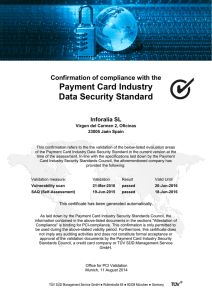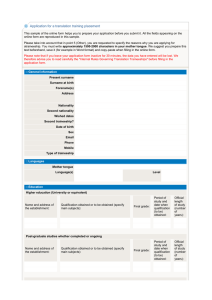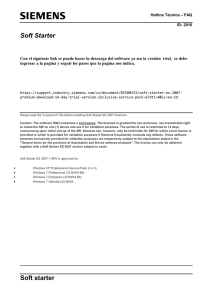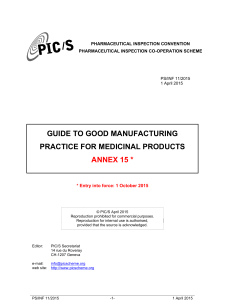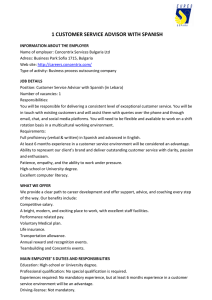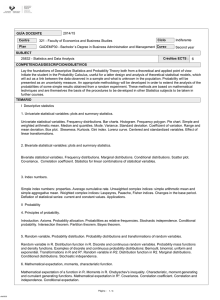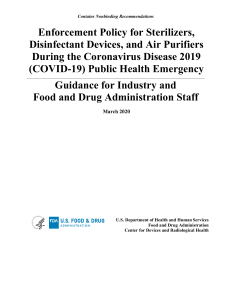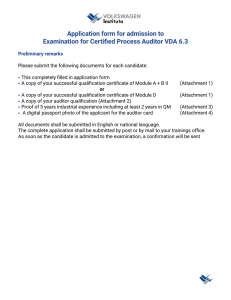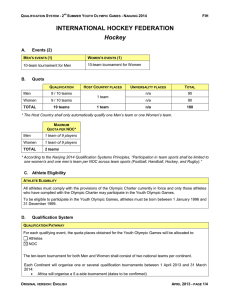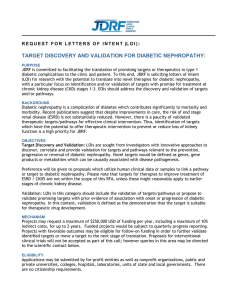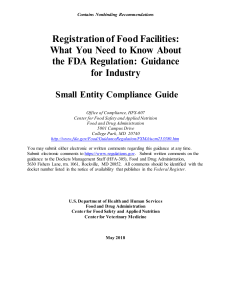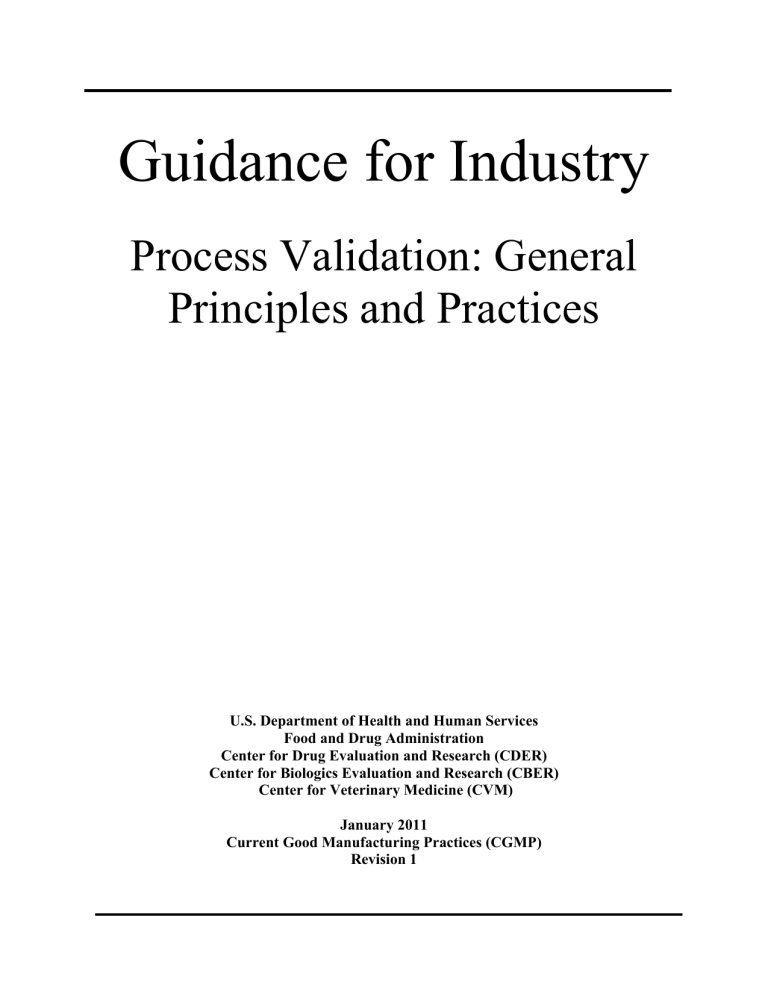
Guidance for Industry Process Validation: General Principles and Practices U.S. Department of Health and Human Services Food and Drug Administration Center for Drug Evaluation and Research (CDER) Center for Biologics Evaluation and Research (CBER) Center for Veterinary Medicine (CVM) January 2011 Current Good Manufacturing Practices (CGMP) Revision 1 Guidance for Industry Process Validation: General Principles and Practices Additional copies are available from: Office of Communications Division of Drug Information, WO51, Room 2201 10903 New Hampshire Ave. Silver Spring, MD 20993 Phone: 301-796-3400; Fax: 301-847-8714 [email protected] http://www.fda.gov/Drugs/GuidanceComplianceRegulatoryInformation/Guidances/default.htm and/or Office of Communication, Outreach and Development, HFM-40 Center for Biologics Evaluation and Research Food and Drug Administration 1401 Rockville Pike, Rockville, MD 20852-1448 (Tel) 800-835-4709 or 301-827-1800 http://www.fda.gov/BiologicsBloodVaccines/GuidanceComplianceRegulatoryInformation/Guidances/default.htm and/or Communications Staff, HFV-12 Center for Veterinary Medicine Food and Drug Administration 7519 Standish Place, Rockville, MD 20855 (Tel) 240-276-9300 http://www.fda.gov/AnimalVeterinary/GuidanceComplianceEnforcement/GuidanceforIndustry/default.htm U.S. Department of Health and Human Services Food and Drug Administration Center for Drug Evaluation and Research (CDER) Center for Biologics Evaluation and Research (CBER) Center for Veterinary Medicine (CVM) January 2011 Current Good Manufacturing Practices (CGMP) Revision 1 Contains Nonbinding Recommendations TABLE OF CONTENTS I. INTRODUCTION............................................................................................................. 1 II. BACKGROUND ............................................................................................................... 3 A. Process Validation and Drug Quality .......................................................................................... 3 B. Approach to Process Validation ................................................................................................... 4 III. STATUTORY AND REGULATORY REQUIREMENTS FOR PROCESS VALIDATION................................................................................................................... 5 IV. RECOMMENDATIONS.................................................................................................. 7 A. General Considerations for Process Validation .......................................................................... 7 B. Stage 1 ― Process Design.............................................................................................................. 8 1. Building and Capturing Process Knowledge and Understanding................................................... 8 2. Establishing a Strategy for Process Control.................................................................................... 9 C. Stage 2 ― Process Qualification ................................................................................................. 10 1. 2. 3. 4. D. Design of a Facility and Qualification of Utilities and Equipment ............................................... 10 Process Performance Qualification............................................................................................... 11 PPQ Protocol................................................................................................................................. 12 PPQ Protocol Execution and Report............................................................................................. 13 Stage 3 ― Continued Process Verification ................................................................................ 14 V. CONCURRENT RELEASE OF PPQ BATCHES ...................................................... 16 VI. DOCUMENTATION...................................................................................................... 17 VII. ANALYTICAL METHODOLOGY.............................................................................. 17 GLOSSARY................................................................................................................................. 18 REFERENCES............................................................................................................................ 19 i Guidance for Industry1 Process Validation: General Principles and Practices This guidance represents the Food and Drug Administration’s (FDA’s) current thinking on this topic. It does not create or confer any rights for or on any person and does not operate to bind FDA or the public. You can use an alternative approach if the approach satisfies the requirements of the applicable statutes and regulations. If you want to discuss an alternative approach, contact the FDA staff responsible for implementing this guidance. If you cannot identify the appropriate FDA staff, call the appropriate number listed on the title page of this guidance. I. INTRODUCTION This guidance outlines the general principles and approaches that FDA considers appropriate elements of process validation for the manufacture of human and animal drug and biological products, including active pharmaceutical ingredients (APIs or drug substances), collectively referred to in this guidance as drugs or products. This guidance incorporates principles and approaches that all manufacturers can use to validate manufacturing processes. This guidance aligns process validation activities with a product lifecycle concept and with existing FDA guidance, including the FDA/International Conference on Harmonisation (ICH) guidances for industry, Q8(R2) Pharmaceutical Development, Q9 Quality Risk Management, and Q10 Pharmaceutical Quality System. 2 Although this guidance does not repeat the concepts and principles explained in those guidances, FDA encourages the use of modern pharmaceutical development concepts, quality risk management, and quality systems at all stages of the manufacturing process lifecycle. 1 This guidance has been prepared by the Division of Manufacturing and Product Quality, Center for Drug Evaluation and Research (CDER), in cooperation with CDER’s Office of Pharmaceutical Sciences, the Center for Biologics Evaluation and Research (CBER), the Office of Regulatory Affairs (ORA) and the Center for Veterinary Medicine (CVM) at the Food and Drug Administration. 2 To make sure you have the most recent version of a guidance, check the CDER guidance page at http://www.fda.gov/Drugs/GuidanceComplianceRegulatoryInformation/Guidances/default.htm, the CBER guidance page at http://www.fda.gov/BiologicsBloodVaccines/GuidanceComplianceRegulatoryInformation/Guidances/default.htm, or the CVM guidance page at http://www.fda.gov/AnimalVeterinary/GuidanceComplianceEnforcement/GuidanceforIndustry/default.htm . Contains Nonbinding Recommendations The lifecycle concept links product and process development, qualification of the commercial manufacturing process, 3 and maintenance of the process in a state of control during routine commercial production. This guidance supports process improvement and innovation through sound science. This guidance covers the following categories of drugs: • Human drugs • Veterinary drugs • Biological and biotechnology products • Finished products and active pharmaceutical ingredients (APIs or drug substances) 4 • The drug constituent of a combination (drug and medical device) product This guidance does not cover the following types of products: • Type A medicated articles and medicated feed • Medical devices 5 • Dietary supplements • Human tissues intended for transplantation regulated under section 361 of the Public Health Service Act 6 This guidance does not specify what information should be included as part of a regulatory submission. Interested persons can refer to the appropriate guidance or contact the appropriate Center in determining the type of information to include in a submission. This guidance also does not specifically discuss the validation of automated process control systems (i.e., computer hardware and software interfaces), which are commonly integrated into modern drug manufacturing equipment. This guidance is relevant, however, to the validation of processes that include automated equipment in processing. 3 In this guidance, the term commercial manufacturing process refers to the manufacturing process resulting in commercial product (i.e., drug that is marketed, distributed, and sold or intended to be sold). For the purposes of this guidance, the term commercial manufacturing process does not include clinical trial or treatment IND material. 4 Separate current good manufacturing practice (CGMP) regulations for drug components such as APIs (drug substances) and intermediates have not published as of the date of this guidance, but these components are subject to the statutory CGMP requirements of section 501(a)(2)(B) of the Federal Food, Drug, and Cosmetic Act (the Act) (21 U.S.C. 351(a)(2)(B)). Process validation for APIs is discussed in the FDA/ICH guidance for industry, Q7 Good Manufacturing Practice Guidance for Active Pharmaceutical Ingredients (ICH Q7), available on the Internet at http://www.fda.gov/Drugs/GuidanceComplianceRegulatoryInformation/Guidances/default.htm. Section XII of ICH Q7 describes in detail the principles for validating API processes. 5 Guidance on process validation for medical devices is provided in a separate document, Quality Management Systems – Process Validation, edition 2, See infra note 6. 6 See the FDA guidance for industry, Validation of Procedures for Processing of Human Tissues Intended for Transplantation, available on the Internet at http://www.fda.gov/BiologicsBloodVaccines/GuidanceComplianceRegulatoryInformation/Guidances/default.htm. 2 Contains Nonbinding Recommendations FDA’s guidance documents, including this guidance, do not establish legally enforceable responsibilities. Instead, guidances describe the Agency’s current thinking on a topic and should be viewed only as recommendations, unless specific regulatory or statutory requirements are cited. The use of the word should in Agency guidances means that something is suggested or recommended, but not required. II. BACKGROUND In the Federal Register of May 11, 1987 (52 FR 17638), FDA issued a notice announcing the availability of a guidance entitled Guideline on General Principles of Process Validation (the 1987 guidance). 7 Since then, we have obtained additional experience through our regulatory oversight that allows us to update our recommendations to industry on this topic. This revised guidance conveys FDA’s current thinking on process validation and is consistent with basic principles first introduced in the 1987 guidance. The revised guidance also provides recommendations that reflect some of the goals of FDA’s initiative entitled “Pharmaceutical CGMPs for the 21st Century ― A Risk-Based Approach,” particularly with regard to the use of technological advances in pharmaceutical manufacturing, as well as implementation of modern risk management and quality system tools and concepts. 8 This revised guidance replaces the 1987 guidance. FDA has the authority and responsibility to inspect and evaluate process validation performed by manufacturers. The CGMP regulations for validating pharmaceutical (drug) manufacturing require that drug products be produced with a high degree of assurance of meeting all the attributes they are intended to possess (21 CFR 211.100(a) and 211.110(a)). A. Process Validation and Drug Quality Effective process validation contributes significantly to assuring drug quality. The basic principle of quality assurance is that a drug should be produced that is fit for its intended use. This principle incorporates the understanding that the following conditions exist: • Quality, safety, and efficacy are designed or built into the product. • Quality cannot be adequately assured merely by in-process and finished-product inspection or testing. 7 The 1987 guidance was prepared by a working group that included representation from the Center for Devices and Radiological Health (CDRH). Since that time, CDRH elected to reference a process validation guidance prepared in cooperation with the Global Harmonization Task Force (GHTF). The principles and recommendations in that document, Quality Management Systems – Process Validation, edition 2 (available on the Internet at http://www.ghtf.org/sg3/sg3-final.html) are also useful to consider for drug manufacturing processes. 8 See “Pharmaceutical cGMPS for the 21st Century — A Risk-Based Approach: Second Progress Report and Implementation Plan,” available at http://www.fda.gov/Drugs/DevelopmentApprovalProcess/Manufacturing/QuestionsandAnswersonCurrentGoodMan ufacturingPracticescGMPforDrugs/ucm071836.htm. 3 Contains Nonbinding Recommendations • Each step of a manufacturing process is controlled to assure that the finished product meets all quality attributes including specifications. B. Approach to Process Validation For purposes of this guidance, process validation is defined as the collection and evaluation of data, from the process design stage through commercial production, which establishes scientific evidence that a process is capable of consistently delivering quality product. Process validation involves a series of activities taking place over the lifecycle of the product and process. This guidance describes process validation activities in three stages. • Stage 1 – Process Design: The commercial manufacturing process is defined during this stage based on knowledge gained through development and scale-up activities. • Stage 2 – Process Qualification: During this stage, the process design is evaluated to determine if the process is capable of reproducible commercial manufacturing. • Stage 3 – Continued Process Verification: Ongoing assurance is gained during routine production that the process remains in a state of control. This guidance describes activities typical of each stage, but in practice, some activities might occur in multiple stages. Before any batch from the process is commercially distributed for use by consumers, a manufacturer should have gained a high degree of assurance in the performance of the manufacturing process such that it will consistently produce APIs and drug products meeting those attributes relating to identity, strength, quality, purity, and potency. The assurance should be obtained from objective information and data from laboratory-, pilot-, and/or commercialscale studies. Information and data should demonstrate that the commercial manufacturing process is capable of consistently producing acceptable quality products within commercial manufacturing conditions. A successful validation program depends upon information and knowledge from product and process development. This knowledge and understanding is the basis for establishing an approach to control of the manufacturing process that results in products with the desired quality attributes. Manufacturers should: • • • • Understand the sources of variation Detect the presence and degree of variation Understand the impact of variation on the process and ultimately on product attributes Control the variation in a manner commensurate with the risk it represents to the process and product Each manufacturer should judge whether it has gained sufficient understanding to provide a high degree of assurance in its manufacturing process to justify commercial distribution of the 4 Contains Nonbinding Recommendations product. Focusing exclusively on qualification efforts without also understanding the manufacturing process and associated variations may not lead to adequate assurance of quality. After establishing and confirming the process, manufacturers must maintain the process in a state of control over the life of the process, even as materials, equipment, production environment, personnel, and manufacturing procedures change. 9 Manufacturers should use ongoing programs to collect and analyze product and process data to evaluate the state of control of the process. These programs may identify process or product problems or opportunities for process improvements that can be evaluated and implemented through some of the activities described in Stages 1 and 2. Manufacturers of legacy products can take advantage of the knowledge gained from the original process development and qualification work as well as manufacturing experience to continually improve their processes. Implementation of the recommendations in this guidance for legacy products and processes would likely begin with the activities described in Stage 3. III. STATUTORY AND REGULATORY REQUIREMENTS FOR PROCESS VALIDATION Process validation for drugs (finished pharmaceuticals and components) is a legally enforceable requirement under section 501(a)(2)(B) of the Act (21 U.S.C. 351(a)(2)(B)), which states the following: A drug . . . shall be deemed to be adulterated . . . if . . . the methods used in, or the facilities or controls used for, its manufacture, processing, packing, or holding do not conform to or are not operated or administered in conformity with current good manufacturing practice to assure that such drug meets the requirements of this Act as to safety and has the identity and strength, and meets the quality and purity characteristics, which it purports or is represented to possess. FDA regulations describing current good manufacturing practice (CGMP) for finished pharmaceuticals are provided in 21 CFR parts 210 and 211. The CGMP regulations require that manufacturing processes be designed and controlled to assure that in-process materials and the finished product meet predetermined quality requirements and do so consistently and reliably. Process validation is required, in both general and specific terms, by the CGMP regulations in parts 210 and 211. The foundation for process validation is provided in § 211.100(a), which states that “[t]here shall be written procedures for production and process control designed to assure that the drug products have the identity, strength, quality, and purity they purport or are represented to possess...” (emphasis added). This regulation requires manufacturers to design a process, including operations and controls, which results in a product meeting these attributes. 9 The statute and regulations described in section III of this guidance explain the requirement that the methods and facilities used for the manufacturing of drugs be operated and administered under control sufficient to assure that the identity, strength, purity, and quality of a drug are as they purport or are represented to possess. 5 Contains Nonbinding Recommendations Other CGMP regulations define the various aspects of validation. For example, § 211.110(a), Sampling and testing of in-process materials and drug products, requires that control procedures “. . . be established to monitor the output and to validate the performance of those manufacturing processes that may be responsible for causing variability in the characteristics of in-process material and the drug product” (emphasis added). Under this regulation, even well-designed processes must include in-process control procedures to assure final product quality. In addition, the CGMP regulations regarding sampling set forth a number of requirements for validation: samples must represent the batch under analysis (§ 211.160(b)(3)); the sampling plan must result in statistical confidence (§ 211.165(c) and (d)); and the batch must meet its predetermined specifications (§ 211.165(a)). In addition to sampling requirements, the CGMP regulations also provide norms for establishing in-process specifications as an aspect of process validation. Section 211.110(b) establishes two principles to follow when establishing in-process specifications. The first principle is that “. . . in-process specifications for such characteristics [of in-process material and the drug product] shall be consistent with drug product final specifications . . . .” Accordingly, in-process material should be controlled to assure that the final drug product will meet its quality requirements. The second principle in this regulation further requires that in-process specifications “. . . shall be derived from previous acceptable process average and process variability estimates where possible and determined by the application of suitable statistical procedures where appropriate.” This requirement, in part, establishes the need for manufacturers to analyze process performance and control batch-to-batch variability. 10 The CGMP regulations also describe and define activities connected with process design, development, and maintenance. Section 211.180(e) requires that information and data about product quality and manufacturing experience be periodically reviewed to determine whether any changes to the established process are warranted. Ongoing feedback about product quality and process performance is an essential feature of process maintenance. In addition, the CGMP regulations require that facilities in which drugs are manufactured be of suitable size, construction, and location to facilitate proper operations (§ 211.42). Equipment must be of appropriate design, adequate size, and suitably located to facilitate operations for its intended use (§ 211.63). Automated, mechanical, and electronic equipment must be calibrated, inspected, or checked according to a written program designed to assure proper performance (§ 211.68). In summary, the CGMP regulations require that manufacturing processes be designed and controlled to assure that in-process materials and the finished product meet predetermined quality requirements and do so consistently and reliably. 10 The Agency further explains this principle in the preamble to the final rule on “Current Good Manufacturing Practice in Manufacture, Processing, Packing, or Holding” (43 FR 45013 at 45052, September 29, 1978) (available on the Internet at http://www.fda.gov/cder/dmpq/preamble.txt). 6 Contains Nonbinding Recommendations IV. RECOMMENDATIONS In the following sections, we describe general considerations for process validation, the recommended stages of process validation, and specific activities for each stage in the product lifecycle. A. General Considerations for Process Validation In all stages of the product lifecycle, good project management and good archiving that capture scientific knowledge will make the process validation program more effective and efficient. The following practices should ensure uniform collection and assessment of information about the process and enhance the accessibility of such information later in the product lifecycle. • We recommend an integrated team approach 11 to process validation that includes expertise from a variety of disciplines (e.g., process engineering, industrial pharmacy, analytical chemistry, microbiology, statistics, manufacturing, and quality assurance). Project plans, along with the full support of senior management, are essential elements for success. • Throughout the product lifecycle, various studies can be initiated to discover, observe, correlate, or confirm information about the product and process. All studies should be planned and conducted according to sound scientific principles, appropriately documented, and approved in accordance with the established procedure appropriate for the stage of the lifecycle. • The terms attribute(s) (e.g., quality, product, component) and parameter(s) (e.g., process, operating, and equipment) are not categorized with respect to criticality in this guidance. With a lifecycle approach to process validation that employs risk based decision making throughout that lifecycle, the perception of criticality as a continuum rather than a binary state is more useful. All attributes and parameters should be evaluated in terms of their roles in the process and impact on the product or in-process material, and reevaluated as new information becomes available. The degree of control over those attributes or parameters should be commensurate with their risk to the process and process output. In other words, a higher degree of control is appropriate for attributes or parameters that pose a higher risk. The Agency recognizes that terminology usage can vary and expects that each manufacturer will communicate the meaning and intent of its terminology and categorization to the Agency. • Many products are single-source or involve complicated manufacturing processes. Homogeneity within a batch and consistency between batches are goals of process validation activities. Validation offers assurance that a process is reasonably protected against sources of variability that could affect production output, cause supply problems, and negatively affect public health. 11 This concept is discussed in more detail in FDA’s guidance for industry, Quality Systems Approach to Pharmaceutical Current Good Manufacturing Practice Regulations, available at http://www.fda.gov/Drugs/GuidanceComplianceRegulatoryInformation/Guidances/default.htm. 7 Contains Nonbinding Recommendations B. Stage 1 ― Process Design Process design is the activity of defining the commercial manufacturing process that will be reflected in planned master production and control records. The goal of this stage is to design a process suitable for routine commercial manufacturing that can consistently deliver a product that meets its quality attributes. 1. Building and Capturing Process Knowledge and Understanding Generally, early process design experiments do not need to be performed under the CGMP conditions required for drugs intended for commercial distribution that are manufactured during Stage 2 (process qualification) and Stage 3 (continued process verification). They should, however, be conducted in accordance with sound scientific methods and principles, including good documentation practices. This recommendation is consistent with ICH Q10 Pharmaceutical Quality System. 12 Decisions and justification of the controls should be sufficiently documented and internally reviewed to verify and preserve their value for use or adaptation later in the lifecycle of the process and product. Although often performed at small-scale laboratories, most viral inactivation and impurity clearance studies cannot be considered early process design experiments. Viral and impurity clearance studies intended to evaluate and estimate product quality at commercial scale should have a level of quality unit oversight that will ensure that the studies follow sound scientific methods and principles and the conclusions are supported by the data. Product development activities provide key inputs to the process design stage, such as the intended dosage form, the quality attributes, and a general manufacturing pathway. Process information available from product development activities can be leveraged in the process design stage. The functionality and limitations of commercial manufacturing equipment should be considered in the process design, as well as predicted contributions to variability posed by different component lots, production operators, environmental conditions, and measurement systems in the production setting. However, the full spectrum of input variability typical of commercial production is not generally known at this stage. Laboratory or pilot-scale models designed to be representative of the commercial process can be used to estimate variability. Designing an efficient process with an effective process control approach is dependent on the process knowledge and understanding obtained. Design of Experiment (DOE) studies can help develop process knowledge by revealing relationships, including multivariate interactions, between the variable inputs (e.g., component characteristics 13 or process parameters) and the resulting outputs (e.g., in-process material, intermediates, or the final product). Risk analysis tools can be used to screen potential variables for DOE studies to minimize the total number of experiments conducted while maximizing knowledge gained. The results of DOE studies can provide justification for establishing ranges of incoming component quality, equipment 12 Available at http://www.fda.gov/Drugs/GuidanceComplianceRegulatoryInformation/Guidances/default.htm. 13 “Component means any ingredient [raw material] intended for use in the manufacture of a drug product, including those that may not appear in such drug product” (§ 210.3(b)(3)). 8 Contains Nonbinding Recommendations parameters, and in-process material quality attributes. FDA does not generally expect manufacturers to develop and test the process until it fails. Other activities, such as experiments or demonstrations at laboratory or pilot scale, also assist in evaluation of certain conditions and prediction of performance of the commercial process. These activities also provide information that can be used to model or simulate the commercial process. Computer-based or virtual simulations of certain unit operations or dynamics can provide process understanding and help avoid problems at commercial scale. It is important to understand the degree to which models represent the commercial process, including any differences that might exist, as this may have an impact on the relevance of information derived from the models. It is essential that activities and studies resulting in process understanding be documented. Documentation should reflect the basis for decisions made about the process. For example, manufacturers should document the variables studied for a unit operation and the rationale for those variables identified as significant. This information is useful during the process qualification and continued process verification stages, including when the design is revised or the strategy for control is refined or changed. 2. Establishing a Strategy for Process Control Process knowledge and understanding is the basis for establishing an approach to process control for each unit operation and the process overall. Strategies for process control can be designed to reduce input variation, adjust for input variation during manufacturing (and so reduce its impact on the output), or combine both approaches. Process controls address variability to assure quality of the product. Controls can consist of material analysis and equipment monitoring at significant processing points (§ 211.110(c)). Decisions regarding the type and extent of process controls can be aided by earlier risk assessments, then enhanced and improved as process experience is gained. FDA expects controls to include both examination of material quality and equipment monitoring. Special attention to control the process through operational limits and in-process monitoring is essential in two possible scenarios: 1. When the product attribute is not readily measurable due to limitations of sampling or detectability (e.g., viral clearance or microbial contamination) or 2. When intermediates and products cannot be highly characterized and well-defined quality attributes cannot be identified. These controls are established in the master production and control records (see § 211.186(a) and (b)(9)). More advanced strategies, which may involve the use of process analytical technology (PAT), can include timely analysis and control loops to adjust the processing conditions so that the output remains constant. Manufacturing systems of this type can provide a higher degree of 9 Contains Nonbinding Recommendations process control than non-PAT systems. In the case of a strategy using PAT, the approach to process qualification will differ from that used in other process designs. Further information on PAT processes can be found in FDA’s guidance for industry on PAT ― A Framework for Innovative Pharmaceutical Development, Manufacturing, and Quality Assurance. 14 The planned commercial production and control records, which contain the operational limits and overall strategy for process control, should be carried forward to the next stage for confirmation. C. Stage 2 ― Process Qualification During the process qualification (PQ) stage of process validation, the process design is evaluated to determine if it is capable of reproducible commercial manufacture. This stage has two elements: (1) design of the facility and qualification of the equipment and utilities and (2) process performance qualification (PPQ). During Stage 2, CGMP-compliant procedures must be followed. Successful completion of Stage 2 is necessary before commercial distribution. 15 Products manufactured during this stage, if acceptable, can be released for distribution. 1. Design of a Facility and Qualification of Utilities and Equipment Proper design of a manufacturing facility is required under part 211, subpart C, of the CGMP regulations on Buildings and Facilities. It is essential that activities performed to assure proper facility design and commissioning precede PPQ. Here, the term qualification refers to activities undertaken to demonstrate that utilities and equipment are suitable for their intended use and perform properly. These activities necessarily precede manufacturing products at the commercial scale. Qualification of utilities and equipment generally includes the following activities: • Selecting utilities and equipment construction materials, operating principles, and performance characteristics based on whether they are appropriate for their specific uses. • Verifying that utility systems and equipment are built and installed in compliance with the design specifications (e.g., built as designed with proper materials, capacity, and functions, and properly connected and calibrated). • Verifying that utility systems and equipment operate in accordance with the process requirements in all anticipated operating ranges. This should include challenging the equipment or system functions while under load comparable to that expected during 14 Available at http://www.fda.gov/Drugs/GuidanceComplianceRegulatoryInformation/Guidances/default.htm. Other references that may be useful include ASTM E2474-06 “Standard Practice for Pharmaceutical Process Design Utilizing Process Analytical Technology” and ASTM E2476-09 “Standard Guide for Risk Assessment and Risk Control as it Impacts the Design, Development, and Operation of PAT Processes for Pharmaceutical Manufacture.” 15 As discussed in section III of this guidance, process validation (including process qualification) is legally enforceable under section 501(a)(2)(B) of the Act. FDA regulations require that process validation procedures be established and followed (§ 211.100) before a batch can be distributed (§§ 211.22 and 211.165). 10 Contains Nonbinding Recommendations routine production. It should also include the performance of interventions, stoppage, and start-up as is expected during routine production. Operating ranges should be shown capable of being held as long as would be necessary during routine production. Qualification of utilities and equipment can be covered under individual plans or as part of an overall project plan. The plan should consider the requirements of use and can incorporate risk management to prioritize certain activities and to identify a level of effort in both the performance and documentation of qualification activities. The plan should identify the following items: 1. the studies or tests to use, 2. the criteria appropriate to assess outcomes, 3. the timing of qualification activities, 4. the responsibilities of relevant departments and the quality unit, and 5. the procedures for documenting and approving the qualification. The project plan should also include the firm’s requirements for the evaluation of changes. Qualification activities should be documented and summarized in a report with conclusions that address criteria in the plan. The quality control unit must review and approve the qualification plan and report (§ 211.22). 2. Process Performance Qualification The process performance qualification (PPQ) is the second element of Stage 2, process qualification. The PPQ combines the actual facility, utilities, equipment (each now qualified), and the trained personnel with the commercial manufacturing process, control procedures, and components to produce commercial batches. A successful PPQ will confirm the process design and demonstrate that the commercial manufacturing process performs as expected. Success at this stage signals an important milestone in the product lifecycle. A manufacturer must successfully complete PPQ before commencing commercial distribution of the drug product. 16 The decision to begin commercial distribution should be supported by data from commercial-scale batches. Data from laboratory and pilot studies can provide additional assurance that the commercial manufacturing process performs as expected. The approach to PPQ should be based on sound science and the manufacturer’s overall level of product and process understanding and demonstrable control. The cumulative data from all relevant studies (e.g., designed experiments; laboratory, pilot, and commercial batches) should be used to establish the manufacturing conditions in the PPQ. To understand the commercial process sufficiently, the manufacturer will need to consider the effects of scale. However, it is not typically necessary to explore the entire operating range at commercial scale if assurance can be provided by process design data. Previous credible experience with sufficiently similar products and processes can also be helpful. In addition, we strongly recommend firms employ 16 See section III of this guidance, Statutory and Regulatory Requirements for Process Validation. 11 Contains Nonbinding Recommendations objective measures (e.g., statistical metrics) wherever feasible and meaningful to achieve adequate assurance. In most cases, PPQ will have a higher level of sampling, additional testing, and greater scrutiny of process performance than would be typical of routine commercial production. The level of monitoring and testing should be sufficient to confirm uniform product quality throughout the batch. The increased level of scrutiny, testing, and sampling should continue through the process verification stage as appropriate, to establish levels and frequency of routine sampling and monitoring for the particular product and process. Considerations for the duration of the heightened sampling and monitoring period could include, but are not limited to, volume of production, process complexity, level of process understanding, and experience with similar products and processes. The extent to which some materials, such as column resins or molecular filtration media, can be re-used without adversely affecting product quality can be assessed in relevant laboratory studies. The usable lifetimes of such materials should be confirmed by an ongoing PPQ protocol during commercial manufacture. A manufacturing process that uses PAT may warrant a different PPQ approach. PAT processes are designed to measure in real time the attributes of an in-process material and then adjust the process in a timely control loop so the process maintains the desired quality of the output material. The process design stage and the process qualification stage should focus on the measurement system and control loop for the measured attribute. Regardless, the goal of validating any manufacturing process is the same: to establish scientific evidence that the process is reproducible and will consistently deliver quality products. 3. PPQ Protocol A written protocol that specifies the manufacturing conditions, controls, testing, and expected outcomes is essential for this stage of process validation. We recommend that the protocol discuss the following elements: • The manufacturing conditions, including operating parameters, processing limits, and component (raw material) inputs. • The data to be collected and when and how it will be evaluated. • Tests to be performed (in-process, release, characterization) and acceptance criteria for each significant processing step. • The sampling plan, including sampling points, number of samples, and the frequency of sampling for each unit operation and attribute. The number of samples should be adequate to provide sufficient statistical confidence of quality both within a batch and between batches. The confidence level selected can be based on risk analysis as it relates to the particular attribute under examination. Sampling during this stage should be more extensive than is typical during routine production. 12 Contains Nonbinding Recommendations • Criteria and process performance indicators that allow for a science- and risk-based decision about the ability of the process to consistently produce quality products. The criteria should include: — A description of the statistical methods to be used in analyzing all collected data (e.g., statistical metrics defining both intra-batch and inter-batch variability). — Provision for addressing deviations from expected conditions and handling of nonconforming data. Data should not be excluded from further consideration in terms of PPQ without a documented, science-based justification. 17 • Design of facilities and the qualification of utilities and equipment, personnel training and qualification, and verification of material sources (components and container/closures), if not previously accomplished. • Status of the validation of analytical methods used in measuring the process, inprocess materials, and the product. • Review and approval of the protocol by appropriate departments and the quality unit. 4. PPQ Protocol Execution and Report Execution of the PPQ protocol should not begin until the protocol has been reviewed and approved by all appropriate departments, including the quality unit. Any departures from the protocol must be made according to established procedure or provisions in the protocol. Such departures must be justified and approved by all appropriate departments and the quality unit before implementation (§ 211.100). The commercial manufacturing process and routine procedures must be followed during PPQ protocol execution (§§ 211.100(b) and 211.110(a)). The PPQ lots should be manufactured under normal conditions by the personnel routinely expected to perform each step of each unit operation in the process. Normal operating conditions should include the utility systems (e.g., air handling and water purification), material, personnel, environment, and manufacturing procedures. A report documenting and assessing adherence to the written PPQ protocol should be prepared in a timely manner after the completion of the protocol. This report should: • Discuss and cross-reference all aspects of the protocol. • Summarize data collected and analyze the data, as specified by the protocol. 17 For additional guidance regarding out-of-specification results, see FDA’s Guidance for Industry, Investigating Out-of-Specification (OOS)Test Results for Pharmaceutical Production, available at http://www.fda.gov/downloads/Drugs/GuidanceComplianceRegulatoryInformation/Guidances/ucm070287.pdf. 13 Contains Nonbinding Recommendations • Evaluate any unexpected observations and additional data not specified in the protocol. • Summarize and discuss all manufacturing nonconformances such as deviations, aberrant test results, or other information that has bearing on the validity of the process. • Describe in sufficient detail any corrective actions or changes that should be made to existing procedures and controls. • State a clear conclusion as to whether the data indicates the process met the conditions established in the protocol and whether the process is considered to be in a state of control. If not, the report should state what should be accomplished before such a conclusion can be reached. This conclusion should be based on a documented justification for the approval of the process, and release of lots produced by it to the market in consideration of the entire compilation of knowledge and information gained from the design stage through the process qualification stage. • Include all appropriate department and quality unit review and approvals. D. Stage 3 ― Continued Process Verification The goal of the third validation stage is continual assurance that the process remains in a state of control (the validated state) during commercial manufacture. A system or systems for detecting unplanned departures from the process as designed is essential to accomplish this goal. Adherence to the CGMP requirements, specifically, the collection and evaluation of information and data about the performance of the process, will allow detection of undesired process variability. Evaluating the performance of the process identifies problems and determines whether action must be taken to correct, anticipate, and prevent problems so that the process remains in control (§ 211.180(e)). An ongoing program to collect and analyze product and process data that relate to product quality must be established (§ 211.180(e)). The data collected should include relevant process trends and quality of incoming materials or components, in-process material, and finished products. The data should be statistically trended and reviewed by trained personnel. The information collected should verify that the quality attributes are being appropriately controlled throughout the process. We recommend that a statistician or person with adequate training in statistical process control techniques develop the data collection plan and statistical methods and procedures used in measuring and evaluating process stability and process capability. 18 Procedures should describe 18 Some references that may be useful include the following: ASTM E2281-03 “Standard Practice for Process and Measurement Capability Indices,” ASTM E2500-07 “Standard Guide for Specification, Design, and Verification of Pharmaceutical and Biopharmaceutical Manufacturing Systems and Equipment,” and ASTM E2709-09 “Standard Practice for Demonstrating Capability to Comply with a Lot Acceptance Procedure.” This is not a complete list of all useful references on this topic. Many industry standards, books, and guides on these topics are available. 14 Contains Nonbinding Recommendations how trending and calculations are to be performed and should guard against overreaction to individual events as well as against failure to detect unintended process variability. Production data should be collected to evaluate process stability and capability. The quality unit should review this information. If properly carried out, these efforts can identify variability in the process and/or signal potential process improvements. Good process design and development should anticipate significant sources of variability and establish appropriate detection, control, and/or mitigation strategies, as well as appropriate alert and action limits. However, a process is likely to encounter sources of variation that were not previously detected or to which the process was not previously exposed. Many tools and techniques, some statistical and others more qualitative, can be used to detect variation, characterize it, and determine the root cause. We recommend that the manufacturer use quantitative, statistical methods whenever appropriate and feasible. Scrutiny of intra-batch as well as inter-batch variation is part of a comprehensive continued process verification program under § 211.180(e). We recommend continued monitoring and sampling of process parameters and quality attributes at the level established during the process qualification stage until sufficient data are available to generate significant variability estimates. These estimates can provide the basis for establishing levels and frequency of routine sampling and monitoring for the particular product and process. Monitoring can then be adjusted to a statistically appropriate and representative level. Process variability should be periodically assessed and monitoring adjusted accordingly. Variation can also be detected by the timely assessment of defect complaints, out-ofspecification findings, process deviation reports, process yield variations, batch records, incoming raw material records, and adverse event reports. Production line operators and quality unit staff should be encouraged to provide feedback on process performance. We recommend that the quality unit meet periodically with production staff to evaluate data, discuss possible trends or undesirable process variation, and coordinate any correction or follow-up actions by production. Data gathered during this stage might suggest ways to improve and/or optimize the process by altering some aspect of the process or product, such as the operating conditions (ranges and setpoints), process controls, component, or in-process material characteristics. A description of the planned change, a well-justified rationale for the change, an implementation plan, and quality unit approval before implementation must be documented (§ 211.100). Depending on how the proposed change might affect product quality, additional process design and process qualification activities could be warranted. 19 Maintenance of the facility, utilities, and equipment is another important aspect of ensuring that a process remains in control. Once established, qualification status must be maintained through routine monitoring, maintenance, and calibration procedures and schedules (21 CFR part 211, 19 Certain manufacturing changes may call for formal notification to the Agency before implementation, as directed by existing regulations (see, e.g., 21 CFR 314.70 and 601.12). 15 Contains Nonbinding Recommendations subparts C and D). The equipment and facility qualification data should be assessed periodically to determine whether re-qualification should be performed and the extent of that re-qualification. Maintenance and calibration frequency should be adjusted based on feedback from these activities. V. CONCURRENT RELEASE OF PPQ BATCHES In most cases, the PPQ study needs to be completed successfully and a high degree of assurance in the process achieved before commercial distribution of a product. In special situations, the PPQ protocol can be designed to release a PPQ batch for distribution before complete execution of the protocol steps and activities, i.e., concurrent release. FDA expects that concurrent release will be used rarely. Concurrent release might be appropriate for processes used infrequently for various reasons, such as to manufacture drugs for which there is limited demand (e.g., orphan drugs, minor use and minor species veterinary drugs) or which have short half lives (e.g., radiopharmaceuticals, including positron emission tomography drugs). Concurrent release might also be appropriate for drugs that are medically necessary and are being manufactured in coordination with the Agency to alleviate a short supply. Conclusions about a commercial manufacturing process can only be made after the PPQ protocol is fully executed and the data are fully evaluated. If Stage 2 qualification is not successful (i.e., does not demonstrate that the process as designed is capable of reproducible performance at commercial scale), then additional design studies and qualification may be necessary. The new product and process understanding obtained from the unsuccessful qualification study(ies) can have negative implications if any lot was already distributed. Full execution of Stages 1 and 2 of process validation is intended to preclude or minimize that outcome. Circumstances and rationale for concurrent release should be fully described in the PPQ protocol. Even when process performance assessment based on the PPQ protocol is still outstanding, any lot released concurrently must comply with all CGMPs, regulatory approval requirements, and PPQ protocol lot release criteria. Lot release under a PPQ protocol is based upon meeting confidence levels appropriate for each quality attribute of the drug. When warranted and used, concurrent release should be accompanied by a system for careful oversight of the distributed batch to facilitate rapid customer feedback. For example, customer complaints and defect reports should be rapidly assessed to determine root cause and whether the process should be improved or changed. Concurrently released lots must also be assessed in light of any negative PPQ study finding or conclusions and appropriate corrective action must be taken (§§ 211.100(a), 211.180(e), and 211.192). We recommend that each batch in a concurrent release program be evaluated for inclusion in the stability program. It is important that stability test data be promptly evaluated to ensure rapid detection and correction of any problems. 16 Contains Nonbinding Recommendations VI. DOCUMENTATION Documentation at each stage of the process validation lifecycle is essential for effective communication in complex, lengthy, and multidisciplinary projects. Documentation is important so that knowledge gained about a product and process is accessible and comprehensible to others involved in each stage of the lifecycle. Information transparency and accessibility are fundamental tenets of the scientific method. They are also essential to enabling organizational units responsible and accountable for the process to make informed, science-based decisions that ultimately support the release of a product to commerce. The degree and type of documentation required by CGMP vary during the validation lifecycle. Documentation requirements are greatest during Stage 2, process qualification, and Stage 3, continued process verification. Studies during these stages must conform to CGMPs and must be approved by the quality unit in accordance with the regulations (see §§ 211.22 and 211.100). Viral and impurity clearance studies, even when performed at small scale, also require quality unit oversight. CGMP documents for commercial manufacturing (i.e., the initial commercial master batch production and control record (§ 211.186) and supporting procedures) are key outputs of Stage 1, process design. We recommend that firms diagram the process flow for the full-scale process. Process flow diagrams should describe each unit operation, its placement in the overall process, monitoring and control points, and the component, as well as other processing material inputs (e.g., processing aids) and expected outputs (i.e., in-process materials and finished product). It is also useful to generate and preserve process flow diagrams of the various scales as the process design progresses to facilitate comparison and decision making about their comparability. VII. ANALYTICAL METHODOLOGY Process knowledge depends on accurate and precise measuring techniques used to test and examine the quality of drug components, in-process materials, and finished products. Validated analytical methods are not necessarily required during product- and process-development activities or when used in characterization studies. Nevertheless, analytical methods should be scientifically sound (e.g., specific, sensitive, and accurate) and provide results that are reliable. There should be assurance of proper equipment function for laboratory experiments. Procedures for analytical method and equipment maintenance, documentation practices, and calibration practices supporting process-development efforts should be documented or described. New analytical technology and modifications to existing technology are continually being developed and can be used to characterize the process or the product. Use of these methods is particularly appropriate when they reduce risk by providing greater understanding or control of product quality. However, analytical methods supporting commercial batch release must follow CGMPs in parts 210 and 211. Clinical supply production should follow the CGMPs appropriate for the particular phase of clinical studies. 17 Contains Nonbinding Recommendations GLOSSARY Capability of a process: Ability of a process to produce a product that will fulfill the requirements of that product. The concept of process capability can also be defined in statistical terms. (ISO 9000:2005) Commercial manufacturing process: The manufacturing process resulting in commercial product (i.e., drug that is marketed, distributed, and sold or intended to be sold). For the purposes of this guidance, the term commercial manufacturing process does not include clinical trial or treatment IND material. Concurrent release: Releasing for distribution a lot of finished product, manufactured following a qualification protocol, that meets the lot release criteria established in the protocol, but before the entire study protocol has been executed. Continued process verification: Assuring that during routine production the process remains in a state of control. Performance indicators: Measurable values used to quantify quality objectives to reflect the performance of an organization, process or system, also known as performance metrics in some regions. (ICH Q10) Process design: Defining the commercial manufacturing process based on knowledge gained through development and scale-up activities. Process qualification: Confirming that the manufacturing process as designed is capable of reproducible commercial manufacturing. Process validation: The collection and evaluation of data, from the process design stage through commercial production, which establishes scientific evidence that a process is capable of consistently delivering quality products. Quality: The degree to which a set of inherent properties of a product, system, or process fulfils requirements. (ICH Q9) State of control: A condition in which the set of controls consistently provides assurance of continued process performance and product quality. (ICH Q10) 18 Contains Nonbinding Recommendations REFERENCES FDA, (CBER), Validation of Procedures for Processing of Human Tissues Intended for Transplantation, guidance for industry, May 2002. FDA, (CDER), Investigating Out-of-Specification (OOS) Test Results for Pharmaceutical Production, guidance for industry, October 2006. FDA, (CDER, CVM, and ORA), PAT — A Framework for Innovative Pharmaceutical Development, Manufacturing, and Quality Assurance, guidance for industry, September 2004. FDA, (CDER, CBER, CVM, and ORA), Quality Systems Approach to Pharmaceutical Current Good Manufacturing Practice Regulations, guidance for industry, September 2006. FDA/Global Harmonization Task Force (GHTF; medical devices), Quality Management Systems – Process Validation, edition 2, guidance, January 2004. FDA/ICH, (CDER and CBER), Q7 Good Manufacturing Practice for Active Pharmaceutical Ingredients, guidance for industry, August 2001. FDA/ICH, (CDER and CBER), Q8(R2) Pharmaceutical Development, guidance for industry, November 2009. FDA/ICH, (CDER and CBER), Q9 Quality Risk Management, guidance for industry, June 2006. FDA/ICH (CDER and CBER) Q10 Pharmaceutical Quality System, guidance for industry, April 2009. ASTM E2474-06 Standard Practice for Pharmaceutical Process Design Utilizing Process Analytical Technology. ASTM E2476-09 Standard Guide for Risk Assessment and Risk Control as it Impacts the Design, Development, and Operation of PAT Processes for Pharmaceutical Manufacture. ASTM E2281-03 Standard Practice for Process and Measurement Capability Indices. ASTM E2500-07 Standard Guide for Specification, Design, and Verification of Pharmaceutical and Biopharmaceutical Manufacturing Systems and Equipment. ASTM E2709-10 Standard Practice for Demonstrating Capability to Comply with a Lot Acceptance Procedure. 19
